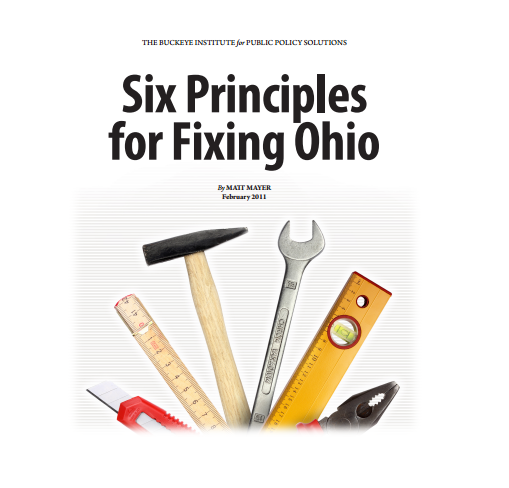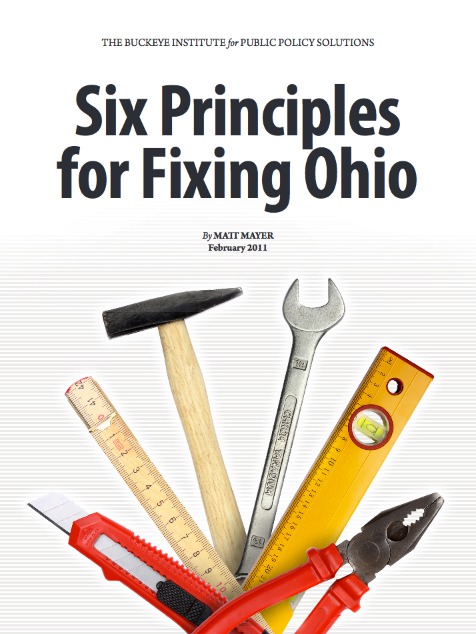By Matt A. Mayer
Executive Summary
Fixing Ohio is going to hurt. Just like all of those Americans who spent the past fifteen years piling up debt on credit cards, buying homes they could not afford, and living lives of immediate gratification, Ohio’s state and local government—bulging with revenues from a growing, but fragile, national economy beginning in 1995—grew to a size simply too large and costly given today’s economic realities.
It is time to start anew. After nearly two decades of irresponsible budgeting that assumed Ohio would always experience a booming economy (when compared to most of the other states, it never did), it makes little fiscal sense to baseline the next budget on the indefensible budgets of yesterday. Ohio’s taxpayers and businesses, beaten and bruised, simply cannot take an even heavier load.
Because of the pending fiscal crisis, we have a rare opportunity to fundamentally reform government and the economy in Ohio. While painful, these reforms can put Ohio on the path to a strong recovery. And make no mistake, if the ruling class fails to tackle the tough challenges ahead and allows the entrenched interests to win, Ohio will become a permanent laggard among the states. Our best and brightest young citizens will certainly continue to migrate South and West.
No matter how fervent a proponent of big government you may be, a vibrant government first requires a vibrant private sector that creates prosperity for Ohioans and drives tax revenue into government. Though attempts were made to strengthen Ohio’s private sector, those efforts largely involved nibbling on the margins of our problems and avoided tackling the consequential issues undermining Ohio’s economic health.
From January 1990 to December 2010, Ohio’s private sector netted a mere 102,200 jobs, or slightly more than 400 jobs per month, over 252 months. After reaching a peak of 4.85 million private-sector jobs in March 2000, Ohio’s job losses over the last ten years were worse than every state except Michigan. At the same time, Ohio added 62,100 government jobs to its cost roll, meaning that for every 1.65 net private-sector jobs created, a new government job was added.
With the loss of over 600,000 private-sector jobs since 2000 and all of the tax revenue collected from those jobs, the status quo across Ohio government units is simply not good enough. We must enact big changes. This report details six key principles that our political leaders should adhere to as they begin the tough process of fixing our state.
PRINCIPLE #1: The Past is No Guide for Today’s Budgets. In 1990, the general revenue fund expenditures for Ohio stood at just under $11.6 billion. By 2009, it had grown to roughly $27 billion. In just 19 years, Ohio’s budget grew by over 131 percent. Even adjusting for inflation, Ohio’s budget outpaced inflation by 41 percent. If Ohio’s political leaders simply had restrained spending to annual inflation plus population growth, Ohio’s general revenue fund expenditures in 2009 would have been roughly $19.3 billion, or $7.5 billion less than the 2009 general revenue fund expenditures. The biennial difference would total $15 billion, which means Ohio today likely would have a healthy surplus instead of a crippling deficit. This $19.3 billion figure should serve as a new baseline for the next budget.
PRINCIPLE #2: Break Labor’s Stranglehold: Freedom Absent from Missouri to Maine. Over the past two decades, forced unionization states had less than half the average net job growth (212,725) as worker freedom states (481,168), which is an average percentage growth of 17 percent versus 37 percent. Seven of the eight states with the strongest job growth—even after the housing and construction busts—are all worker freedom states: Nevada (78percent), Utah (74 percent), Arizona (67 percent), Idaho (65 percent), North Dakota (51 percent), Wyoming (51 percent), and Texas (50 percent). In contrast, the fifteen states with the weakest job growth are all forced unionization states that form a block from Missouri to Maine, plus California and Hawaii.
PRINCIPLE #3: Put Taxpayers and Vulnerable Populations Ahead of Government Pay Scales and Public-Sector Unions. There are more than 11.5 million Ohioans of which roughly 777,000 work for some government entity. At most, just under 3.0 million Ohioans work for government or are dependents of government workers. The remaining 8.5 million Ohioans, or 74 percent, fund government. If the compensation packages of government workers are not reined in and the power of government unions are not curbed, private-sector taxpayers and Ohio’s vulnerable populations will be forced to carry even more of the burden of the new economic normal via higher taxes and more significant program cuts.
PRINCIPLE #4: Government Retirements Should Mirror What the Rest of Us Have. For the vast majority of Ohioans, the Social Security program represents the largest element of their retirements. In order to receive the full benefits of the Social Security program, private-sector Ohioans must wait until they are 67 years old. In stark contrast, state government workers can retire with full pension benefits after just 30 years, making many able to retire when they are 52 years old (48 years old for fire and police personnel). With a life expectancy of 78 years, these young retirees will collect their pensions almost as long as they worked for government. Michigan switched to defined-contribution plans for new state workers back in 1997 and Democrat-led Illinois made the switch effective January 1, 2011. What is stopping Ohio from these reforms?
PRINCIPLE #5: Make Thinking Outside the Box More Than a Slogan. The list of problems facing Ohio is long, but with creative thinking, can be eliminated. The list of areas where real reforms can result in measurable, long-term improvements include state and local tax reform; government transparency, consolidation, and productivity improvement; criminal justice reform; and higher education reform. If we want innovative thinking, we must look at these areas anew and from a different angle.
PRINCIPLE #6: Demand the Federal Government Respect Our Ability to Get Things Done. After seventy-plus years of centralization in Washington, it is time we take seriously the ideas of decentralization and federalism. It goes without saying that any money Ohio receives from Washington is really just our own money coming back—minus an “administrative fee” to pay for the bureaucracy—to us with strings attached or unfunded mandates. Does this really make sense (as if it ever did)? We must restore the balance of power between the federal government and the states. For too long, the states have lacked a check on the power and arrogance emanating out of Washington. Let the fifty states keep their money and run their own programs.
To read the rest of the report, click here: Six Principles


